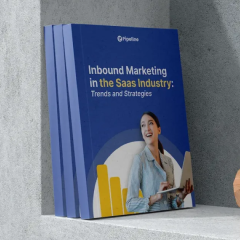
Demand generation vs inbound marketing share common goals but employ distinct strategies in the pursuit of customer engagement and business growth. Both aim to attract potential customers, generate interest, and convert leads into loyal patrons.
However, their approaches vary significantly. Understanding the nuances and applications of these two methods is vital for crafting a successful marketing strategy that aligns with your specific business objectives.
Demand generation vs inbound marketing are two strategies aimed at attracting and converting potential customers, but they differ in their tactics. While demand generation often delivers quick results, inbound marketing builds long-term relationships.
Choosing the right strategy depends on your target audience and marketing objectives, and often a combination of both yields the best results.
Demand generation strategies aim to create interest and awareness in a company's products or services. These strategies encompass tactics like digital marketing and brand awareness to attract a broad audience and nurture long-term customer relationships, ultimately driving sales and revenue.
This is a critical goal for businesses, and data-driven leads play a pivotal role in this process. By leveraging data analytics and lead scoring, both teams can identify and prioritize leads with the highest potential for conversion.
Considering what is demand generation vs lead generation, both are important strategies in marketing. Demand generation builds brand awareness and trust, while lead generation focuses on capturing contact information from prospects showing interest in a particular product or service.
This alignment ensures that marketing efforts are focused on delivering high-quality leads to the sales team. Leading to more efficient and targeted outreach. Data-driven leads provide valuable insights into customer behavior and preferences, enabling better-tailored messaging and strategies.
Utilizing intent data is invaluable for determining the optimal moment to engage with prospects. This data provides insights into a prospect's online behavior and activity, indicating when they are actively researching or considering a purchase.
By analyzing this information, businesses can time their outreach precisely, delivering relevant content or offers when prospects are most receptive. This proactive approach maximizes the chances of conversion and fosters a deeper understanding of customer needs.
It aligns marketing efforts with prospect intent, enhancing efficiency and personalization while improving the overall effectiveness of lead nurturing and engagement strategies.
Timing impacts the accuracy of insights and the effectiveness of strategies. For real-time trends, frequent monitoring is crucial, allowing prompt adjustments. However, for long-term performance, regularly scheduled assessments are ideal.
By aligning metric tracking with business objectives, such as weekly for short-term campaigns or quarterly for overall growth, organizations can maintain a balanced focus on both immediate and long-term goals.
Effective timing ensures that data-driven insights are actionable, offering a competitive edge and the ability to adapt strategies swiftly and make informed decisions that contribute to business success.
Account-based metrics are essential for businesses with a B2B focus. These metrics emphasize the performance and engagement of specific target accounts rather than individual leads. Key account-based metrics include account engagement score, pipeline velocity, and deal acceleration rate.
By focusing on these metrics, businesses can gain a holistic view of account health, track the progress of high-value deals, and fine-tune their marketing and sales strategies to better align with the needs and preferences of their most important clients.
Inbound marketing strategies revolve around attracting customers organically through valuable content. Tactics include digital marketing. This approach fosters trust, educates prospects, and draws them into the sales funnel. It focuses on providing solutions and building lasting customer relationships.
Attracting clients is an important goal for businesses. To achieve this, companies employ various strategies in demand generation vs brand awareness. That is effective marketing, strong online presence, and delivering quality products or services.
Content marketing, search engine optimization (SEO), and targeted advertising draw potential clients in. Including networking and referrals. Building trust through a consistent brand image and quality customer service is vital.
Demonstrating expertise and addressing client needs through educational content and personalized approaches further enhance the attraction process.
Engaging with clients is important for successful businesses. It involves creating meaningful interactions, actively listening to their needs, and providing personalized solutions. Communication channels like emails, social media, and face-to-face meetings facilitate engagement.
In this demand generation vs product marketing realm, responding promptly to inquiries, seeking feedback, and addressing concerns all contribute to fostering strong client relationships. Engaging clients also includes delivering value through educational content and exclusive offers, ensuring their needs are met while encouraging loyalty.
Engaging with clients is a continuous process that not only satisfies their immediate requirements but also builds long-term trust, loyalty, and advocacy, contributing to business growth and success.
Delighting clients is the core of the demand generation vs demand fulfillment realm. It includes delivering exceptional customer service, surprise and delight gestures, and consistently providing value.
Going the extra mile, offering personalized recommendations, and actively seeking feedback show clients their importance. Delighting clients not only fosters loyalty but turns them into brand advocates who promote your business.
Satisfied customers become your best marketers. This approach builds a positive brand reputation, sets you apart from competitors, and drives client retention and referrals, ultimately contributing to long-term business success and growth.
Inbound marketing and demand generation are closely intertwined strategies that work in harmony to attract and convert customers. Inbound marketing, through content creation, SEO, and social media, generate interest by providing valuable information.
Demand generation complements this by capturing and nurturing that interest through lead generation and targeted campaigns. The relationship lies in the fact that inbound marketing is a fundamental part of demand generation, laying the groundwork for interest and brand awareness.
Together, these strategies create a cohesive marketing approach that attracts, engages, and converts leads into customers. As in the realm of demand generation vs ABM (account-based marketing). Thus, driving business growth and revenue by optimizing the entire customer journey.
In summary, demand generation vs inbound marketing synergizes to create a comprehensive and effective marketing strategy. Inbound marketing sets the stage by attracting and engaging prospects, while demand generation captures and converts that interest into actual leads.
Complete that by balancing demand capture vs demand generation. By converting existing demand and leads to sales. This cohesive approach maximizes results and drives business growth.
Get your B2B company discovered with Pipeline's account-based marketing strategy. Our tailored solutions are designed to pinpoint your ideal target market and ensure your products or services are discovered by those actively seeking them. Let us help you stand out in Indonesia's market – Get discovered today with Pipeline
Consult with us now! It's free.


